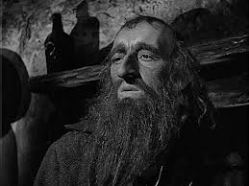David Lean’s 1948 film Oliver Twist is almost a straight adaptation of Charles Dickens’ novel. The only major plot device missing is Rose Maylie’s subplot, and the film is no less of an epic tale because of this slight. However, some of the film’s nuances say much more about the time period around which the film was released.
The Jewish element was emphasized through Fagin, and in fact the movie was banned for three years in the U.S. for being anti-Semitic. However, I don’t think it’s necessarily as black and white as some people would have had viewers believe. Granted, Fagin’s makeup, particularly his prosthetic nose, brings his Jewishness to the forefront, and he is portrayed as greedy, stingy, and abusive to the boys under his charge.
David Lean’s version of Fagin plays up his Jewish heritage, adding an obviously fake nose for the finishing touches.
However, there are undertones of the Holocaust near the end of the film that suggest a different side to the story. The band of thieves have barricaded themselves in their lodgings, complete with piles of wood in front of the doors. This behavior alludes to the Holocaust, when Jews went into hiding from the Nazis. The angry mob of citizens, who come “in the name of the king,” resemble an impending regiment of soldiers. To make things even more obvious, when Fagin is confronted by the men, he says, “Strike them all dead! What right have you to butcher me?” One can’t ignore this allusion to the horrors of the Holocaust. In this way, I think Lean uses the Jewish stereotype just to subvert it.
Lean’s technical applications such as angles and cuts provide another layer to the already complex storyline. His use of high angles showcases the idea of observation. For example, at the beginning of the film, the boys in the workhouse are seen looking down upon the board members, who are feasting upon meals the boys can only dream of. The camera looks up at the boys, which would usually indicate that they are in a position of power. A similar shot occurs when Nancy watches the exchange between Fagin and Monks. She is also presented at a high angle, but she is observing them in secret and is in constant fear of being discovered. Both of these scenes serve to indicate that the women and children within them are not held in regard: they do not have power and, as Nancy’s death will prove, they are disposable.
Lean’s use of cuts, especially within the first few scenes, elaborate on the satire that is an important facet of the original novel. For example, when discussing conditions in the workhouse, the board is shown discussing their dwindling powers of punishment. One member indicates that the workhouses have become places of entertainment. Immediately after his comment, Lean cuts to an actual scene in the workhouse, in which the inmates are working their fingers to the bone. This adds to the idea of a blindly ignorant government that can be a danger to society.
Overall, the 1948 film doesn’t change much about Dickens’ classic; it simply modernizes it to relate to the times in which it was filmed.

